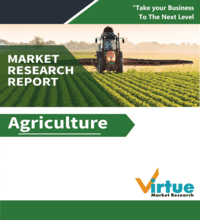Greenhouse horticulture Market Size (2025 – 2030)
The Greenhouse Horticulture Market was valued at USD 34.78 Billion in 2024 and is projected to reach a market size of USD 58.5 Billion by the end of 2030. Over the forecast period of 2025-2030, the market is projected to grow at a CAGR of 9.05%.
The greenhouse horticulture market focuses on the cultivation of plants within controlled environments, enabling consistent and high-quality production regardless of seasonal or climatic conditions. Greenhouses provide a regulated atmosphere that allows farmers to manage temperature, humidity, light, and irrigation to meet the specific needs of different crops.
This approach is widely used for fruits, vegetables, flowers, and ornamental plants, supporting both commercial agriculture and specialized cultivation. The market integrates advanced technologies such as automated climate control systems, LED grow lighting, and precision irrigation to optimize yields and resource efficiency. Materials like glass, polyethylene, and polycarbonate are commonly used for greenhouse construction, each offering distinct benefits in terms of insulation, light transmission, and durability. Rising demand for sustainable farming practices has encouraged the adoption of renewable energy sources, such as solar panels, within greenhouse operations. Urban and peri-urban farming initiatives are also driving interest in compact and modular greenhouse designs. The sector attracts investment from both traditional agricultural producers and technology-driven agribusiness firms, reflecting its role in addressing global food security challenges.
Key Market Insights:
In 2024, the global greenhouse horticulture market was valued at approximately USD 35 billion.
Fruits and vegetables dominated the crop-type segment, holding around 52% of the global greenhouse horticulture market in 2024.
In the material segment, rigid panels accounted for the largest share of greenhouse construction in 2024.
Europe led the global market in 2024, commanding approximately 38.1% of the greenhouse horticulture market share.
Hydroponic systems used in greenhouses in 2024 were able to reduce water usage by up to 90% compared to traditional soil-based farming.
Market Drivers:
Rising Demand for Year-Round Crop Production is Driving the Adoption of Greenhouse Horticulture
The increasing need for uninterrupted food supply, regardless of seasonal variations, is pushing growers toward greenhouse-based farming. Controlled environments allow farmers to produce crops throughout the year without relying on natural weather conditions. This ensures consistent quality, reduces supply chain volatility, and supports stable pricing for fresh produce. Urban population growth and changing dietary preferences, especially the rising consumption of fresh fruits and vegetables, are further fueling this demand. Retailers and wholesalers are favoring greenhouse-grown products for their uniform appearance and reduced spoilage risk. As a result, commercial-scale greenhouse projects are becoming more common across both developed and emerging economies.
Integration of Advanced Technologies is Enhancing Productivity and Efficiency in Greenhouse Operations
Technological innovations such as automated climate control, IoT-based monitoring, and precision irrigation are revolutionizing greenhouse horticulture. These solutions enable farmers to maintain optimal growing conditions while minimizing resource wastage. LED grow lights allow tailored light spectra for specific crops, improving growth rates and reducing energy consumption compared to traditional lighting. Data analytics and AI-powered systems help predict plant health issues early, reducing dependency on chemical pesticides. The use of renewable energy, like solar panels, is lowering operational costs and aligning with sustainability goals. This convergence of agriculture and technology is making greenhouse farming more profitable, scalable, and resilient to environmental challenges.
Market Restraints and Challenges:
Setting up a greenhouse requires significant capital expenditure for structures, climate control systems, irrigation setups, and advanced monitoring technologies. For many small and medium-scale farmers, these costs remain a major barrier, especially in regions with limited access to financing or subsidies. Beyond installation, ongoing expenses for energy, repairs, and system upgrades can be substantial, affecting profitability. In areas with high electricity costs, operating climate control and lighting systems can quickly erode margins. Additionally, skilled labor is often required to manage advanced greenhouse operations, further increasing operational expenses. These financial and resource constraints slow down adoption, particularly in developing markets.
Market Opportunities:
The rising global emphasis on sustainable food production is creating a strong market opportunity for greenhouse farming solutions. Controlled environments allow for efficient use of resources such as water and fertilizers, aligning with eco-friendly agricultural practices. Urban areas, facing space constraints and high food demand, are increasingly adopting rooftop and vertical greenhouse setups to supply fresh produce locally. Advancements in modular and portable greenhouse designs are making adoption easier for small-scale farmers and urban entrepreneurs. Governments and private investors are also supporting greenhouse projects through subsidies and funding, recognizing their role in food security. This trend is expected to unlock new business models and partnerships across both agriculture and technology sectors.
Greenhouse Horticulture MARKET REPORT COVERAGE:
|
REPORT METRIC |
DETAILS |
|
Market Size Available |
2024 - 2030 |
|
Base Year |
2024 |
|
Forecast Period |
2025 - 2030 |
|
CAGR |
9.05%. |
|
Segments Covered |
By Type of Greenhouse Structure, Technology Type, Crop Type, and Region |
|
Various Analyses Covered |
Global, Regional & Country Level Analysis, Segment-Level Analysis, DROC, PESTLE Analysis, Porter’s Five Forces Analysis, Competitive Landscape, Analyst Overview on Investment Opportunities |
|
Regional Scope |
North America, Europe, APAC, Latin America, Middle East & Africa |
|
Key Companies Profiled |
Richel Group SA, Heliospectra AB, Lumigrow Inc., Netafim Ltd., Rough Brothers Inc., Priva Holding BV, Ridder Holding Harderwijk BV, Argus Control Systems Ltd., Logiqs BV, Top Greenhouses Ltd. |
Greenhouse Horticulture Market Segmentation:
Greenhouse Horticulture Market Segmentation by Type of Greenhouse Structure
- Glass Greenhouses
- Plastic Greenhouses
- Others (e.g., polycarbonate)
Plastic greenhouse structures—including polyethylene and PVC variants—constitute approximately 85% of the global greenhouse horticulture market in 2024, making them the dominant material choice. They’re favored due to their affordability, lightweight nature, robust durability, and strong resistance to UV, moisture, and corrosion. Their high light transmission capabilities also support effective plant growth while providing good insulation for climate control. Overall, these advantages make plastic greenhouses the go-to option for most growers globally.
Despite plastic's prevalence, glass greenhouses are witnessing the fastest growth, with compelling expansion trends projected through 2025–2030. Their popularity is gaining traction thanks to superior light transmission, higher temperature control, and increased longevity. Glass structures support high-intensity plant production systems and sophisticated climate management—appealing especially to premium and controlled environment growers. As growers seek quality, durability, and scalability, glass greenhouses are emerging as a rapidly growing alternative.
Greenhouse Horticulture Market Segmentation by Technology Type
- Cooling Systems
- Heating Systems
- LED Grow Lights
- Control & Automation Systems
Within greenhouse technology, cooling systems account for about 35% of the market share in 2024, making them the most widely adopted component. Cooling systems—such as evaporative cooling and fan-and-vent setups—are critical for preventing heat stress, regulating humidity, and ensuring optimal plant growth, especially in warmer climates. These systems enhance photosynthesis, reduce disease risk, and help maintain consistent production standards across diverse geographies. Their essential role in maintaining internal greenhouse environments cements their status as the most deployed technology.
Looking ahead, the “other technologies” category—which includes innovative automation, sensors, and advanced climate control systems—is the fastest-growing technology segment, with a forecasted CAGR of 11.79% over 2025–2030. This reflects increasing adoption of data-driven and IoT-enabled solutions that optimize resource use, monitor environmental parameters in real time, and improve operational efficiency. Growers are investing in smart systems capable of precise control and predictive adjustments, particularly for energy, humidity, and CO₂ regulation. This emerging tech-driven wave is reshaping how modern greenhouses are managed and operated.
Greenhouse Horticulture Market Segmentation by Crop Type
- Fruits & Vegetables
- Flowers & Ornamentals
- Nursery Crops
The fruits and vegetables segment commands the largest share of the greenhouse horticulture market, representing around 67.9% in 2024. This dominance is driven by robust global demand for fresh, nutritious produce and the advantage of greenhouse systems offering year-round cultivation of staples like tomatoes, cucumbers, peppers, berries, and lettuce. These crops typically deliver quicker harvest cycles, higher yields per square meter, and attractive profitability for growers and investors. As a result, fruits and vegetables remain foundational to greenhouse farming strategies worldwide.
Moreover, the fruits and vegetables segment is also the fastest-growing crop category, projected to maintain a strong CAGR through the forecast period. Constant consumer demand, growing health awareness, and food security considerations are fueling its rapid expansion within greenhouse environments. These crops benefit from technological advancements and optimized growing systems that enhance yield, quality, and economic return. This dual position—as both largest and fastest-growing—underscores the strategic importance of fruits and vegetables in greenhouse horticulture.
Greenhouse Horticulture Market Segmentation: Regional Analysis:
- North America
- Europe
- Asia-Pacific
- South America
- Middle East & Africa
Europe holds the largest share of the global greenhouse horticulture market, accounting for around 38.1% in 2024. The region has a long history of advanced greenhouse farming, particularly in the Netherlands, Spain, and Italy, which are known for high-tech production of vegetables, flowers, and ornamental plants. Strong government support, advanced automation technologies, and well-established export networks contribute to Europe’s dominance. Additionally, consumer preference for locally grown, high-quality produce sustains strong domestic demand across the region.
The Asia-Pacific region is projected to experience the fastest growth in the greenhouse horticulture market over the forecast period. Rapid urbanization, increasing population, and rising food demand are driving investment in controlled-environment agriculture across countries like China, India, and Japan. Technological adoption is accelerating, with growers embracing cost-effective plastic greenhouse structures and smart farming systems to improve yield and efficiency. Government initiatives promoting food security and water-efficient farming methods are further boosting greenhouse adoption in the region.
Greenhouse Horticulture Market COVID-19 Impact Analysis:
The COVID-19 pandemic had a mixed impact on the greenhouse horticulture market, disrupting supply chains while also highlighting the importance of resilient food production systems. Lockdowns and restrictions caused delays in equipment deliveries, labor shortages, and difficulties in transporting produce, affecting operational efficiency for many growers. However, the crisis also accelerated the adoption of advanced automation and remote monitoring technologies to reduce dependency on manual labor. Consumer demand for fresh, locally produced fruits and vegetables increased, prompting investments in greenhouse farming as a secure and consistent supply source. Many governments recognized greenhouse horticulture as essential for food security, leading to supportive policies and funding initiatives. Overall, the pandemic acted as both a short-term operational challenge and a long-term growth catalyst for the industry.
Latest Trends and Developments:
The greenhouse horticulture market is witnessing a surge in the integration of smart farming technologies, including IoT-based sensors, AI-driven climate control, and predictive analytics for crop health management. LED grow lighting is becoming increasingly popular due to its energy efficiency, customizable light spectra, and ability to boost crop yields in controlled environments. There is a growing shift toward sustainable greenhouse operations, with more facilities adopting solar panels, rainwater harvesting, and closed-loop irrigation systems to reduce environmental impact. Urban and rooftop greenhouse farming projects are gaining traction, particularly in densely populated cities where space is limited. Advances in modular and portable greenhouse designs are making it easier for small-scale and urban growers to adopt the technology. Collaborations between agritech companies and greenhouse operators are also driving innovation in automation, crop genetics, and energy-efficient climate systems.
Key Players in the Market:
1. Richel Group SA
2. Heliospectra AB
3. Lumigrow Inc.
4. Netafim Ltd.
5. Rough Brothers Inc.
6. Priva Holding BV
7. Ridder Holding Harderwijk BV
8. Argus Control Systems Ltd.
9. Logiqs BV
10. Top Greenhouses Ltd.
Market News:
- In 2024, Certhon and DENSO announced the opening of a fully automated, robot-driven greenhouse facility in Japan, designed to produce tomatoes year-round. The high-tech greenhouse integrates AI-based climate control, robotic harvesting, and automated nutrient delivery to improve yield efficiency and reduce labor dependency.
- In 2024, Netafim introduced a new precision irrigation and climate management solution tailored for large-scale greenhouse vegetable production. The system uses real-time data from sensors to optimize water and nutrient delivery, enabling up to 30% water savings while maintaining crop quality.
- In 2025, Priva launched its next-generation Priva Connected platform, offering centralized control for greenhouse climate, irrigation, and energy management. The cloud-based system integrates predictive analytics and remote access features to help growers improve operational efficiency and reduce energy costs.
In 2025, Heliospectra unveiled a smart LED grow lighting solution with dynamic light spectrum adjustment for greenhouse horticulture. Early adopters reported up to 18% faster growth cycles for leafy greens and herbs, along with reduced energy consumption compared to traditional lighting systems.
Chapter 1. Greenhouse Horticulture Market – SCOPE & METHODOLOGY
1.1. Market Segmentation
1.2. Scope, Assumptions & Limitations
1.3. Research Methodology
1.4. Primary End-user Application .
1.5. Secondary End-user Application
Chapter 2. GREENHOUSE HORTICULTURE MARKET – EXECUTIVE SUMMARY
2.1. Market Size & Forecast – (2025 – 2030) ($M/$Bn)
2.2. Key Trends & Insights
2.2.1. Demand Side
2.2.2. Supply Side
2.3. Attractive Investment Propositions
2.4. COVID-19 Impact Analysis
Chapter 3. GREENHOUSE HORTICULTURE MARKET – COMPETITION SCENARIO
3.1. Market Share Analysis & Company Benchmarking
3.2. Competitive Strategy & Development Scenario
3.3. Competitive Pricing Analysis
3.4. Supplier-Distributor Analysis
Chapter 4. GREENHOUSE HORTICULTURE MARKET - ENTRY SCENARIO
4.1. Regulatory Scenario
4.2. Case Studies – Key Start-ups
4.3. Customer Analysis
4.4. PESTLE Analysis
4.5. Porters Five Force Model
4.5.1. Bargaining Frontline Workers Training of Suppliers
4.5.2. Bargaining Risk Analytics s of Customers
4.5.3. Threat of New Entrants
4.5.4. Rivalry among Existing Players
4.5.5. Threat of Substitutes Players
4.5.6. Threat of Substitutes
Chapter 5. GREENHOUSE HORTICULTURE MARKET - LANDSCAPE
5.1. Value Chain Analysis – Key Stakeholders Impact Analysis
5.2. Market Drivers
5.3. Market Restraints/Challenges
5.4. Market Opportunities
Chapter 6. GREENHOUSE HORTICULTURE MARKET – By Type of Greenhouse Structure
6.1 Introduction/Key Findings
6.2 Glass Greenhouses
6.3 Plastic Greenhouses
6.4 Others (e.g., polycarbonate
6.7 Y-O-Y Growth trend Analysis By Type of Greenhouse Structure
6.8 Absolute $ Opportunity Analysis By Type of Greenhouse Structure , 2025-2030
Chapter 7. GREENHOUSE HORTICULTURE MARKET – By Technology Type
7.1 Introduction/Key Findings
7.2 Cooling Systems
7.3 Heating Systems
7.4 LED Grow Lights
7.5 Control & Automation Systems
7.5 Y-O-Y Growth trend Analysis By Technology Type
7.6 Absolute $ Opportunity Analysis By Technology Type, 2025-2030
Chapter 8. GREENHOUSE HORTICULTURE MARKET – By Crop Type
8.1 Introduction/Key Findings
8.2 Fruits & Vegetables
8.3 Flowers & Ornamentals
8.4 Nursery Crops
8.5 Y-O-Y Growth trend Analysis By Crop Type
8.6 Absolute $ Opportunity Analysis By Crop Type, 2025-2030
Chapter 9. GREENHOUSE HORTICULTURE MARKET – By Geography – Market Size, Forecast, Trends & Insights
9.1. North America
9.1.1. By Country
9.1.1.1. U.S.A.
9.1.1.2. Canada
9.1.1.3. Mexico
9.1.2. By Type of Greenhouse Structure
9.1.3. By Technology Type
9.1.4. By Crop Type
9.1.5. Countries & Segments - Market Attractiveness Analysis
9.2. Europe
9.2.1. By Country
9.2.1.1. U.K.
9.2.1.2. Germany
9.2.1.3. France
9.2.1.4. Italy
9.2.1.5. Spain
9.2.1.6. Rest of Europe
9.2.2. By Type of Greenhouse Structure
9.2.3. By Technology Type
9.2.4. By Crop Type
9.2.5. Countries & Segments - Market Attractiveness Analysis
9.3. Asia Pacific
9.3.1. By Country
9.3.1.1. China
9.3.1.2. Japan
9.3.1.3. South Korea
9.3.1.4. India
9.3.1.5. Australia & New Zealand
9.3.1.6. Rest of Asia-Pacific
9.3.2. By Type of Greenhouse Structure
9.3.3. By Technology Type
9.3.4. By Crop Type
9.3.5. Countries & Segments - Market Attractiveness Analysis
9.4. South America
9.4.1. By Country
9.4.1.1. Brazil
9.4.1.2. Argentina
9.4.1.3. Colombia
9.4.1.4. Chile
9.4.1.5. Rest of South America
9.4.2. By Type of Greenhouse Structure
9.4.3. By Technology Type
9.4.4. By Crop Type
9.4.5. Countries & Segments - Market Attractiveness Analysis
9.5. Middle East & Africa
9.5.1. By Country
9.5.1.1. United Arab Emirates (UAE)
9.5.1.2. Saudi Arabia
9.5.1.3. Qatar
9.5.1.4. Israel
9.5.1.5. South Africa
9.5.1.6. Nigeria
9.5.1.7. Kenya
9.5.1.8. Egypt
9.5.1.9. Rest of MEA
9.5.2. By Type of Greenhouse Structure
9.5.3. By Technology Type
9.5.4. By Crop Type
9.5.5. Countries & Segments - Market Attractiveness Analysis
Chapter 10. GREENHOUSE HORTICULTURE MARKET – Company Profiles – (Overview, Type of Training Portfolio, Financials, Strategies & Developments)
10.1 Richel Group SA
10.2 Heliospectra AB
10.3 Lumigrow Inc.
10.4 Netafim Ltd.
10.5 Rough Brothers Inc.
10.6 Priva Holding BV
10.7 Ridder Holding Harderwijk BV
10.8 Argus Control Systems Ltd.
10.9 Logiqs BV
10.10 Top Greenhouses Ltd.
Download Sample
Choose License Type
2500
4250
5250
6900
Frequently Asked Questions
The greenhouse horticulture market is driven by the rising demand for year-round production of fresh fruits, vegetables, and ornamentals, regardless of seasonal or climatic constraints. Technological advancements, such as automated climate control, precision irrigation, and energy-efficient LED lighting, are enabling higher yields and improved resource efficiency.
High initial investment and operational costs, especially for advanced climate and automation systems, limit adoption among small and medium-scale growers. Additionally, energy dependency and the need for skilled labor to operate high-tech greenhouses create ongoing operational challenges.
Richel Group SA, Heliospectra AB, Lumigrow Inc., Netafim Ltd., Rough Brothers Inc., Priva Holding BV, Ridder Holding Harderwijk BV, Argus Control Systems Ltd., Logiqs BV, Top Greenhouses Ltd., etc.
Europe holds the largest share of the global greenhouse horticulture market, accounting for around 38.1% in 2024. This dominance is supported by advanced farming technologies, strong export capabilities, and government-backed sustainability initiatives.
Asia-Pacific is the fastest-growing region in the greenhouse horticulture market. Rapid urbanization, rising food demand, and increasing government investment in controlled-environment agriculture are fueling this growth.



